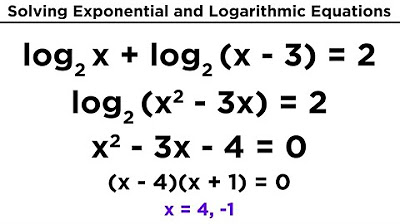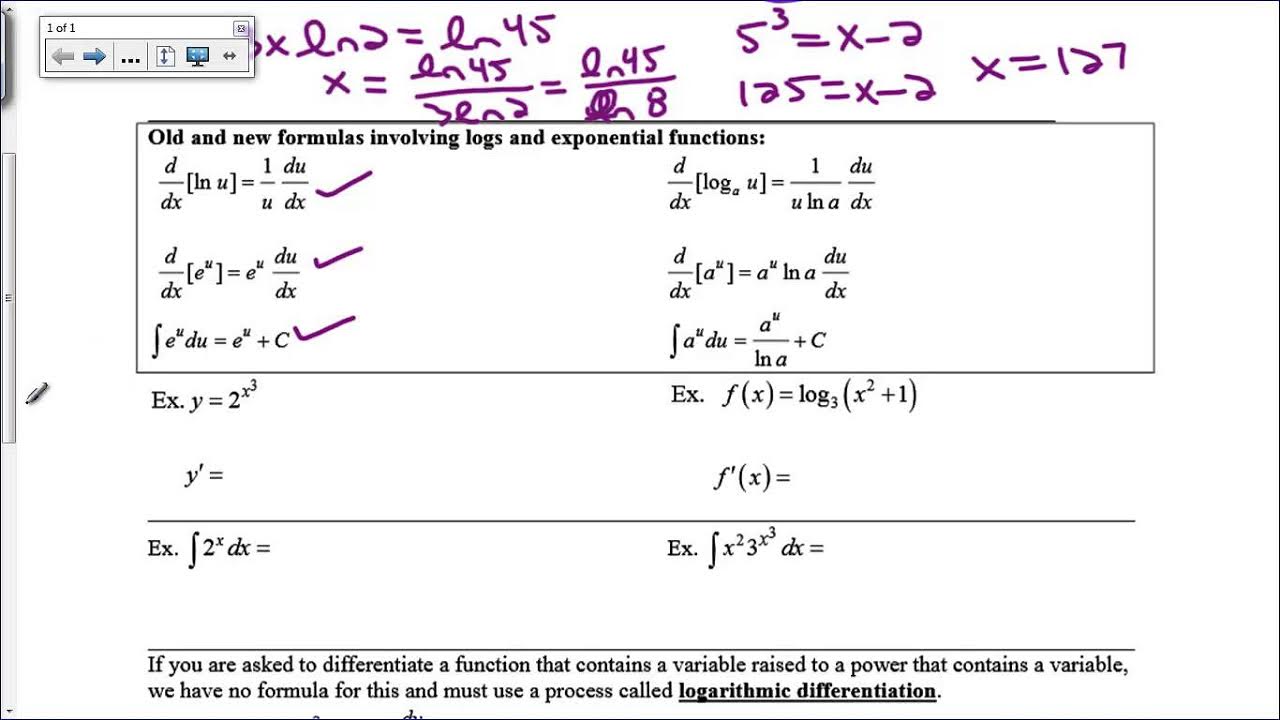Solving Logarithmic Equations With Different Bases - Algebra 2 & Precalculus
TLDRThis video tutorial focuses on solving logarithmic equations with different bases, emphasizing the change of base formula. The instructor demonstrates how to convert logarithms into different bases to simplify and solve equations. Key examples include evaluating logarithms, making bases consistent, and applying properties of logarithms to solve for variables. The video covers practical steps for manipulating logarithmic expressions and solving complex equations, providing detailed explanations and problem-solving techniques. By the end, viewers will understand how to approach and solve logarithmic equations efficiently using various mathematical strategies.
Takeaways
- 🔍 The focus of the video is on solving logarithmic equations with different bases.
- 📐 The change of base formula is crucial: log base a of B is equal to log B / log a.
- 🔢 You can change the base to any other base (e.g., 2, 5, 8) and the equation remains valid.
- 🔄 Example: log base 9 of 27 can be written as log 27 / log 9 using any base.
- 🔎 For simplicity, it's often best to use a common base that divides both numbers (e.g., base 3 for 9 and 27).
- 🧮 Log base 3 of 9 equals 2 because 3^2 is 9, and log base 3 of 27 equals 3 because 3^3 is 27.
- 🧩 When solving log base equations, convert both sides to the same base to simplify.
- 🧠 Use the change of base formula to equate logarithmic expressions with different bases.
- 📝 When bases are the same, equate the contents inside the log expressions to solve for variables.
- 🧪 Example problem: Solve log base 3 of (x - 2) = log base 27 of (4x + 7) by changing both to base 3.
- 🔧 Simplify complex expressions using properties of logarithms and basic algebraic operations.
- 💡 For logarithmic expressions with addition or subtraction, combine them into a single log using properties like log A - log B = log (A / B).
- 🔨 Convert logarithmic equations to exponential form to solve for variables more easily.
- 📊 Utilize tools like Pascal's Triangle or the binomial theorem to expand and simplify polynomial expressions.
- 🔍 Checking solutions by substituting back into the original equations ensures accuracy and validity.
Q & A
What is the change of base formula for logarithms?
-The change of base formula for logarithms is given by log base a of B is equal to log B divided by log a, where the new base can be any number.
How can you evaluate log base 9 of 27 using the change of base formula?
-You can write log base 9 of 27 as log 27 divided by log 9 and choose a new base that is a common factor of 9 and 27, such as 3. Therefore, it simplifies to log base 3 of 27 divided by log base 3 of 9, which equals 3/2.
How do you solve the equation log base 3 of (x - 2) equals log base 27 of (4x + 7) for x?
-First, use the change of base formula to convert both logarithms to the same base. After simplifying, equate the arguments of the logarithms and solve for x, resulting in x = 5.
What property of logarithms allows you to move a constant in front to the exponent position?
-The property is that a constant multiplier in front of a logarithm can be moved to the exponent position of the argument inside the logarithm.
How do you convert a logarithmic equation into its exponential form?
-To convert log base a of b equals c into its exponential form, you rewrite it as a raised to the power of c equals b.
What is the result of log base 2 of 16?
-The result of log base 2 of 16 is 4, because 2 raised to the power of 4 equals 16.
How can you solve log base 8 of 16 plus log base 2 of x equals 10/3?
-First, convert log base 8 of 16 to log base 2, simplify, then subtract and solve the remaining logarithmic equation in exponential form to find x equals 4.
What steps are involved in solving the equation log base 2 of (x + 3) plus log base 4 of (5 - x) equals 3?
-Convert log base 4 to log base 2, combine the logarithms, convert to exponential form, and solve for x. The solution is x = 1.
How do you simplify log base 3 of (3x) minus log base 3 of (3x) equals 1?
-Use the change of base formula to convert log base 9 to log base 3, simplify the subtraction of logarithms, and solve the resulting equation to find the solution.
What is the solution to the equation log base 9 of (200x + 129) minus log base 3 of (3x) equals 1?
-Using the change of base formula, simplify and convert to exponential form, solve the resulting quadratic equation, and verify that x equals 3 is the solution.
Outlines
🔢 Introduction to Solving Logarithmic Equations
This paragraph introduces the topic of solving logarithmic equations with different bases. It emphasizes the importance of understanding the change of base formula, which allows conversion between logarithmic bases. An example using log base 9 of 27 is provided, demonstrating the conversion to log base 3. The example illustrates how to simplify logarithmic expressions by choosing a suitable base and reducing the expression.
📝 Solving Logarithmic Equations: Example 1
The paragraph continues with a detailed example where the logarithmic bases are different, specifically log base 3 and log base 27. The process involves making the bases the same using the change of base formula. The solution steps include transforming the bases, simplifying the logarithmic expressions, and solving for x. Techniques like moving constants in front of logarithms to the exponent position and equating the insides of logarithmic expressions are discussed.
🔍 Applying Binomial Theorem and Synthetic Division
In this paragraph, the focus shifts to solving a logarithmic equation involving the binomial theorem and synthetic division. The process of foiling expressions and using the binomial theorem for expansion is explained. The paragraph also covers identifying possible zeros using synthetic division and verifying if they solve the equation. It concludes with a detailed example involving polynomial coefficients and synthetic division.
💡 Exploring More Complex Logarithmic Equations
This section delves into solving more complex logarithmic equations that involve transforming logarithms into exponential forms. The use of log base changes, converting logarithmic expressions into their exponential equivalents, and solving for variables is discussed. An example equation is provided, showing how to handle coefficients and exponents within logarithmic expressions.
🧮 Techniques for Solving Cubic Polynomial Equations
The paragraph addresses solving cubic polynomial equations using synthetic division and other algebraic techniques. It emphasizes identifying factors and zeros, verifying solutions, and applying the quadratic formula when necessary. The example involves detailed steps in synthetic division, highlighting the process of checking solutions and handling non-factorable expressions.
📊 Advanced Logarithmic Equation Solving
Here, the focus is on solving advanced logarithmic equations involving multiple transformations and logarithmic properties. The use of the change of base formula, converting logarithms to exponential forms, and simplifying complex expressions are detailed. An example equation demonstrates handling square roots, exponents, and quadratic expressions.
🔄 Validating Solutions and Identifying Extraneous Solutions
The final paragraph discusses validating solutions to logarithmic equations and identifying extraneous solutions. It emphasizes the importance of checking for negative values inside logarithms, which are not valid. An example problem is solved, verifying that the obtained solution meets all conditions of the original equation, and ensuring no extraneous solutions are included.
Mindmap
Keywords
💡Logarithmic equations
💡Change of base formula
💡Exponentiation
💡Synthetic division
💡Logarithmic properties
💡Base
💡Quadratic formula
💡Pascal's Triangle
💡Exponential form
💡Extraneous solutions
Highlights
Introduction to solving logarithmic equations with different bases.
Explanation of the change of base formula: log base a of B equals log B / log a.
Example of evaluating log base 9 of 27 using the change of base formula.
Demonstration of choosing the appropriate base, using base 3 for simplicity.
Step-by-step solution of log base 9 of 27 equals log 27 / log 9 with base 3.
Explanation of solving a logarithmic equation with different bases: log base 3 of x - 2 equals log base 27 of 4x + 7.
Using the change of base formula to simplify and solve the equation by making the bases the same.
Conversion of log base 3 of 27 into base 3 and solving the resulting expression.
Introduction to the binomial theorem and its application in expanding expressions.
Explanation of synthetic division to simplify and solve polynomial equations.
Step-by-step synthetic division to find the roots of the polynomial expression.
Introduction to solving logarithmic equations involving multiple terms and different bases.
Converting and simplifying logarithmic expressions to base 2 for easier computation.
Explanation of converting logarithmic equations to exponential form for solving.
Final example of solving a logarithmic equation using the change of base formula and converting to exponential form.
Verification of the solution by plugging values back into the original equation to check accuracy.
Transcripts
Browse More Related Video

Business Calculus -- Math 1329 -- Section 4.2 -- Logarithmic Functions

Solving Logarithmic Equations with Exponentials (Precalculus - College Algebra 63)

Solving Exponential and Logarithmic Equations

Introduction to Solving Logarithms and Exponentials (Precalculus - College Algebra 57)

Bases other than e

Solving Logarithmic Equations
5.0 / 5 (0 votes)
Thanks for rating: